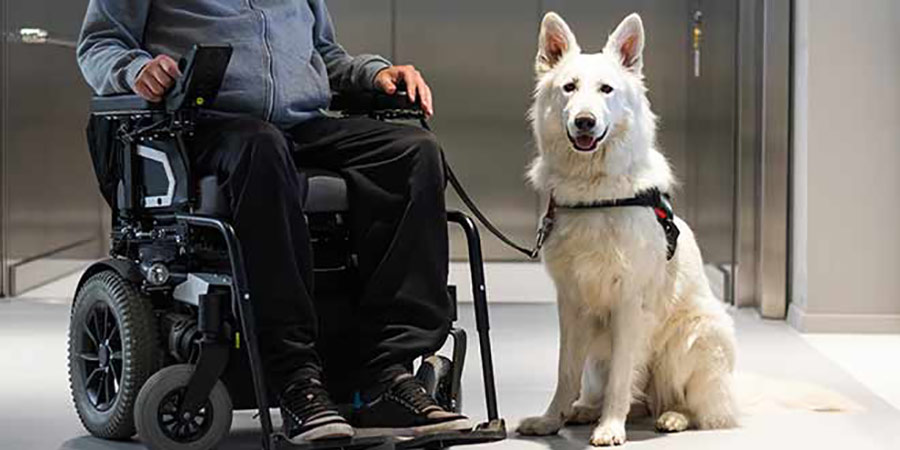A variety of animals lend themselves as assistance animals—whether as a service animal, an emotional support animal (ESA), or therapy animal—to provide various services and comfort to humans.
What is a service animal?

The Americans with Disabilities Act (ADA) defines a service animal as:
“Any dog that is individually trained to do work or perform tasks for the benefit of an individual with a disability, including a physical, sensory, psychiatric, intellectual, or other mental disability. Other species of animals, whether wild or domestic, trained or untrained, are not service animals for the purposes of this definition. The work or tasks performed by a service animal must be directly related to the individual’s disability.
Examples of work or tasks include, but are not limited to, assisting individuals who are blind or have low vision with navigation and other tasks, alerting individuals who are deaf or hard of hearing to the presence of people or sounds, providing nonviolent protection or rescue work, pulling a wheelchair, assisting an individual during a seizure, alerting individuals to the presence of allergens, retrieving items such as medicine or the telephone, providing physical support and assistance with balance and stability to individuals with mobility disabilities, and helping persons with psychiatric and neurological disabilities by preventing or interrupting impulsive or destructive behaviors. The crime deterrent effects of an animal’s presence and the provision of emotional support, well-being, comfort, or companionship do not constitute work or tasks for the purposes of this definition.”

A service animal must be under the control of its handler at all times. Under the ADA, service animals must be harnessed, leashed, or tethered, unless the individual’s disability prevents using these devices or these devices interfere with the service animal’s safe, effective performance of tasks. In that case, the individual must maintain control of the animal through voice, signal, or other effective controls. Service animals are working animals, not pets. Dogs whose sole function is to provide comfort or emotional support do not qualify as service animals under the ADA (see also “What are emotional support animals?” below). Some state and local laws define a service animal more broadly than the ADA. Information about such laws can be obtained from the relevant state attorney general’s office.
What is an assistance animal?

Assistance animals visit hospitals, hospice centers, and other healthcare facilities. These animals provide love and comfort to the patients and/or owner. They may be particularly helpful for people with anxiety and depression by providing emotional stability.
Assistance animals are not considered pets. As per the U.S. Department of Housing and Urban Development, an assistance animal is defined as:
“Any animal that works, provides assistance, or performs tasks for the benefit of a person with a disability, or provides emotional support that alleviates one or more identified symptoms or effects of a person’s disability, as defined by the ADA. Individuals with a disability may be entitled to keep an assistance animal as a reasonable accommodation in housing facilities that otherwise impose restrictions or prohibitions on animals.”
Most assistance animals are dogs, but they can also be another type of animal. For example, a horse named Dr. Peyo (https://www.youtube.com/watch?v=qXn94K-3l5o) provides comfort to cancer patients in France.
What are emotional support animals and therapy animals?
An emotional support animal (ESA) may be an animal of any species, the use of which is supported by a qualified physician, psychiatrist, or other mental health professional based on a disability-related need. An ESA does not have to be trained to perform any particular task. ESAs do not qualify as service animals under the Americans with Disabilities Act, but they may be permitted as reasonable accommodations for persons with disabilities under the Fair Housing Act. The Air Carrier Access Act provides specific allowances for ESAs traveling on airlines, though documentation may need to be provided.
A therapy animal is part of an animal-assisted intervention in which there is a “goal directed intervention in which an animal meeting specific criteria is an integral part of the treatment process. Animal-assisted therapy is provided in a variety of settings, and may be group or individual in nature.”
“Service animals are working animals, not pets.”
Under what circumstances can a service dog be denied access to a facility?

Under the ADA, state and local governments, businesses, and nonprofit organizations that serve the public generally must allow service animals to accompany people with disabilities in all areas of the facility where the public is allowed to go. For example, in a hospital it usually would be inappropriate to exclude a service animal from areas such as patient rooms, clinics, cafeterias, or examination rooms. However, it may be appropriate to exclude a service animal from operating rooms or burn units where the animal’s presence may compromise a sterile environment.
When it is not obvious what service an animal provides, only limited inquiries are allowed. Staff may ask two questions: 1) is the dog a service animal required because of a disability, and 2) what work or task has the dog been trained to perform. Staff cannot ask about the person’s disability, require medical documentation, require a special identification card or training documentation for the dog, or ask that the dog demonstrate its ability to perform the work or task.
Allergies and fear of dogs are not valid reasons for denying access or refusing service to people using service animals. When a person who is allergic to dog dander and a person who uses a service animal must spend time in the same room or facility, for example, in a school classroom or at a homeless shelter, they both should be accommodated by assigning them, if possible, to different locations within the room or different rooms in the facility.

A person with a disability cannot be asked to remove his service animal from the premises unless: 1) the dog is out of control and the handler does not take effective action to control it or 2) the dog is not housebroken. When there is a legitimate reason to ask that a service animal be removed, staff must offer the person with the disability the opportunity to obtain goods or services without the animal’s presence.
Establishments that sell or prepare food must generally allow service animals in public areas even if state or local health codes prohibit animals on the premises.
People with disabilities who use service animals cannot be isolated from other patrons, treated less favorably than other patrons, or charged fees that are not charged to other patrons without animals. In addition, if a business requires a deposit or fee to be paid by patrons with pets, it must waive the charge for service animals.
If a business such as a hotel normally charges guests for damage that they cause, a customer with a disability may also be charged for damage caused by himself or his service animal. Staff are not required to provide care for or supervision of a service animal.
What are the regulations for miniature horses as service animals?

ADA regulations include a separate provision pertaining to miniature horses that have been individually trained to do work or perform tasks for people with disabilities. (Miniature horses generally range in height from 24 inches to 34 inches measured to the shoulders and generally weigh between 70 and 100 pounds.) Entities covered by the ADA must modify their policies to permit miniature horses where reasonable. The regulations set out four assessment factors to assist entities in determining whether miniature horses can be accommodated in their facility. The assessment factors are 1) whether the miniature horse is housebroken; 2) whether the miniature horse is under the owner’s control; 3) whether the facility can accommodate the miniature horse’s type, size, and weight; and 4) whether the miniature horse’s presence will not compromise legitimate safety requirements necessary for safe operation of the facility.
What other roles do animals play in healthcare?

Not only are dogs wonderful service or emotional support animals, dogs are also trained to detect diseases such as cancer. The In Situ Foundation (https://dogsdetectcancer.org/) created the first medical protocol for the selection, training, and handing of a medical scent detection dog. The foundation trains cancer detecting dogs for their own organization and universities.
Use of a trained diabetes alert dog (DAD) to recognize an impending episode of hypoglycemia is a recent trend in diabetes management. These dogs are particularly useful for those with hypoglycemic unawareness. How this works is not completely understood, but it is recognized that the DAD employs its heightened sense of smell to detect certain odors produced by the human body during an episode of hypoglycemia. Once the DAD perceives this odor, they warn their owner by initiating certain behaviors such as placing their paws on the owner’s lap, jumping up on their lap, touching their nose, or alerting other family members that the patient needs help.
DADs have been found to be of special benefit to children with diabetes, especially in detecting nighttime episodes of hypoglycemia and alerting parents to the child’s condition. However, many agencies that provide DADs do not serve children due to the complexities of having to train the dog to meet the needs of both the child with diabetes and their family. There is also concern that children under the age of 12 years are not capable of independently managing a dog outside of the home. In some states, a child who wants to bring a DAD to school must pay for the cost of a handler to assist with the dog.
Researchers partners in Hawai’i and the United Kingdom are conducting a study to teach dogs to detect the scent of COVID-19, including the delta strain, using sweat samples. Once trained, the goal is for these detection dogs to be deployed at places like hospitals, airports, schools, and other public places to provide rapid, noninvasive screening for COVID-19. However, logistics, costs, and the lack of official standards remain as issues to be addressed in order for dogs to serve effectively in medical fields.
SOURCES
American Veterinary Medical Association. (2021). Animal-assisted interventions: definitions. https://www.avma.org/resources-tools/avma-policies/animal-assisted-interventions-definitions
Assistance Dogs of Hawaii. (2021). COVID-19 scent detection. https://www.assistancedogshawaii.org/get-involved-1
Fachetti L. (2018). Diabetes alert dogs: everything you need to know. The Diabetes Council. https://www.thediabetescouncil.com
Gorman J. (2021). Covid-sniffing dogs are accurate but face hurdles for widespread use. New York Times. https://www.nytimes.com/2021/06/12/science/covid-sniffing-dogs.html
Theguardian.org. (2021). “Doctor Peyo”: the horse comforting cancer patients in Calais. https://www.theguardian.com/society/gallery/2021/mar/12/doctor-peyo-the-horse-comforting-cancer-patients-in-calais-in-pictures
U.S. Department of Housing and Urban Development (HUD). (2013). Service animal FHEO notice. https://www.hud.gov/sites/dfiles/FHEO/documents/19ServiceAnimalNoticeFHEO_508.pdf
U.S. Department of Justice (DOJ). (2021). Information and technical assistance on the Americans with Disabilities Act. https://www.ada.gov/index.html
U.S. Department of Transportation (DOT). (2009). 14 CFR 382.117 – Must carriers permit passengers with a disability to travel with service animals? https://www.govinfo.gov/app/details/CFR-2012-title14-vol4/CFR-2012-title14-vol4-sec382-117/context
U.S. Department of Transportation (DOT). (n.d.). What airline employees, airline contractors, and air travelers with disabilities need to know about access to air travel for persons with disabilities. https://www.transportation.gov/sites/dot.gov/files/docs/TAM-07-15-05_1.pdf
Sign up for our newsletter email list and like us on Facebook and Instagram to be among the first to know about all our special discounts and offers!
About Wild Iris Medical Education:
Wild Iris Medical Education, Inc., is a privately held, woman-owned company providing online healthcare continuing education. In 1998, we began offering online ANCC-accredited nursing continuing education courses and since then have expanded to provide CEUs for occupational therapists, physical therapists, paramedics, EMTs, and other healthcare professionals.
Accredited and Approved Nationwide.
High-quality CEU Courses since 1998.

Join Our More Than 750,000 Satisfied Customers Now!
High-quality, accredited, evidenced-based continuing education courses in an easy-to-use format designed for learning, from Wild Iris Medical Education. We’ve been providing online CE since 1998.



